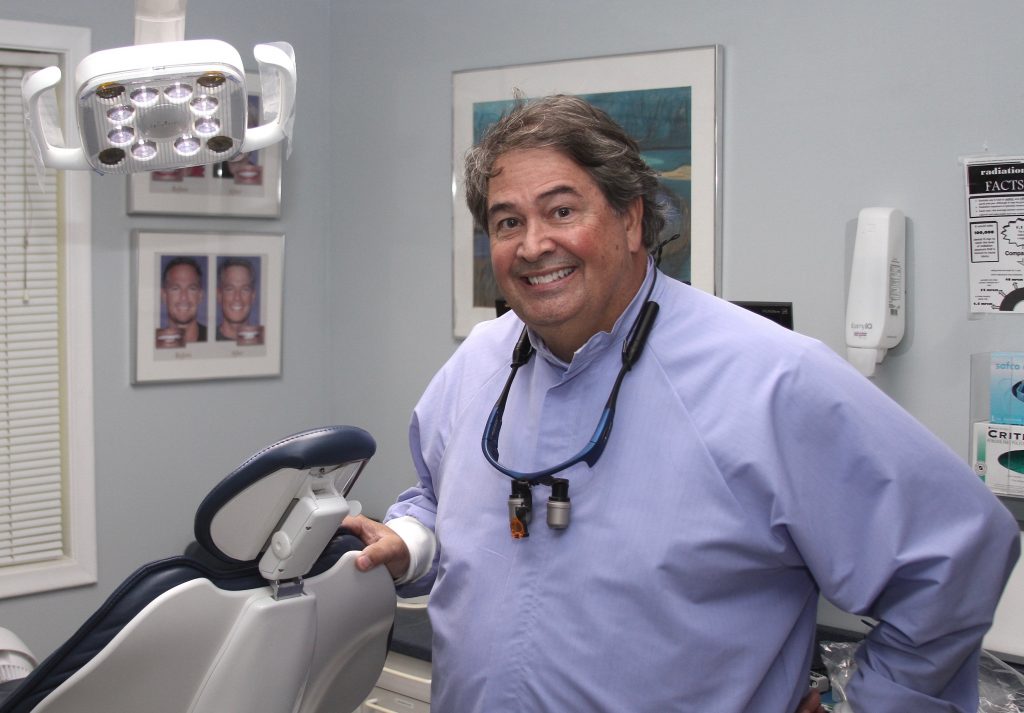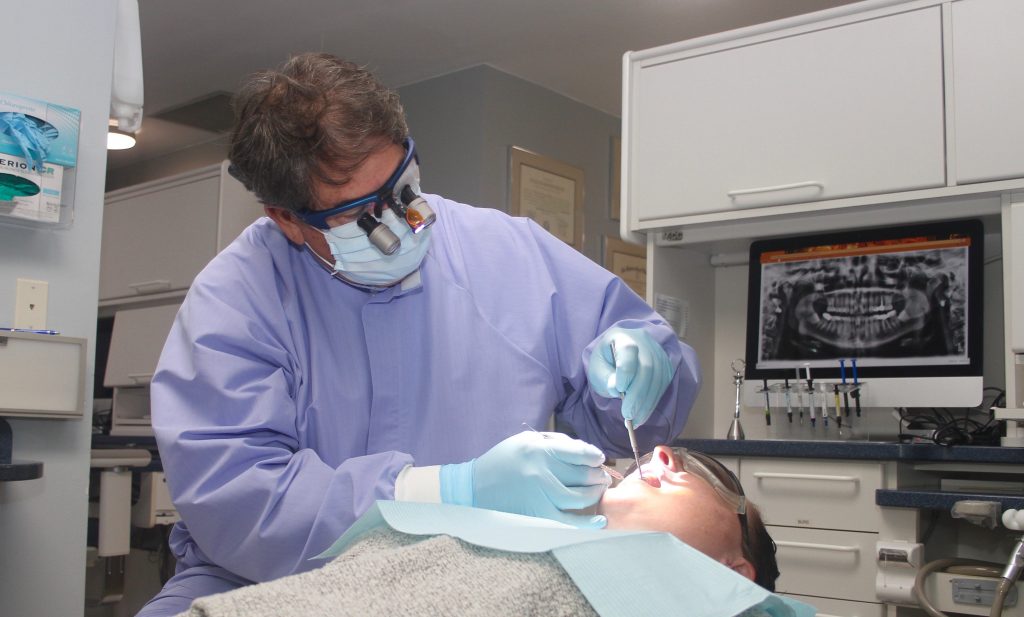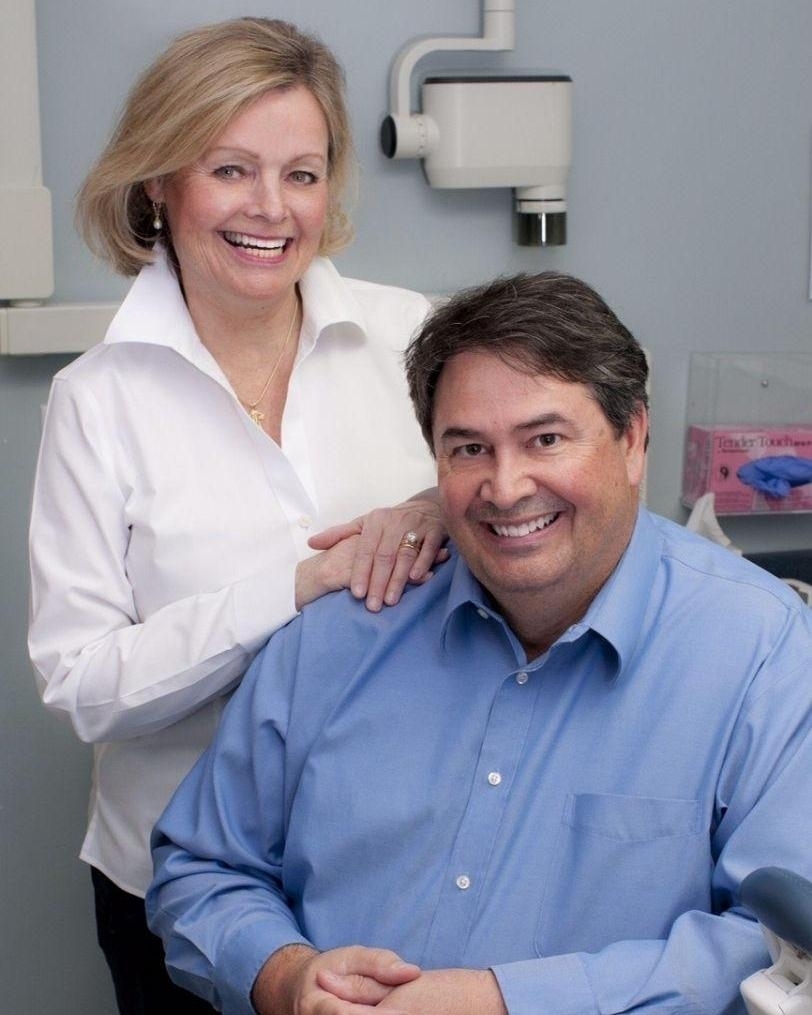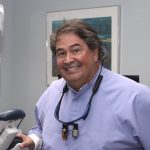Alumni Profile: Dr. Mark Johnston (DDS 1985) – Serving patients and the profession of dentistry12 min read

Dr. Mark Johnston told his wife, Mary, recently that one of these days he needs to learn how to say no to volunteer opportunities. It’s not something he has done much of over the 36 years of his dentistry career so far.
His CV is crowded with not just membership in local, state and national dentistry organizations, but leadership positions at all levels as well.
A 1985 graduate of the School of Dentistry, Johnston has a general dentistry practice in Lansing, Michigan. Like many longtime dentists, he has a patient base that includes people he began treating as children and now they bring their children and sometimes grandchildren to him.
“The thing about general dentistry versus specialty dentistry is that I often see the patient several times a year. I love that,” he says. He knows many of his patients well enough to call them friends. “I love that,” he repeats, acknowledging the repetition with a shrug because there is no better way to describe that close bond and satisfaction he gets from helping patients.
And when you are doing something you love, why not be active in that profession’s organizations, to the point of volunteering for leadership positions?
Not long after Johnston graduated from dental school, organized dentistry decided to increase its commitment to helping beginning dentists get started with their careers. The state and national dental associations created a program called New Dentists and Johnston was in the first such group in Michigan. After he went to a national meeting for the group, he saw the value of networking at the highest level. He liked the idea of contributing to the profession. “After that, I just never stopped,” he said.
He has held many leadership roles, including president, for the Central District Dental Society, which represents dentists in Lansing and several adjacent counties, then began to expand on the state level. In 2007, he became the Michigan Dental Association liaison to the Michigan State Board of Dentistry (and more recently has been a member of that state board since 2017, currently as chair). In 2011, he began a run of office-holding on the MDA Board of Trustees that led to president of the state organization in 2015-16. He’s been on MDA committees related to technology, member success, Membership Think Tank, young dentists and professional placement. He still serves on the committee related to Dental Assisting. Since 2000, he has also been involved in numerous committees and initiatives of the MDA’s Insurance and Financial Group.
MDA and beyond
His time as MDA president was marked by several key issues that required him to engage with the political process and learn about lobbying for dental issues at all levels. One successful debate was convincing the state legislature to update an outdated law regarding certification for use of cone beam computed tomography, so the technology could be used in dental offices in addition to hospitals. There were dental insurance issues and continuing debates about state and federal reimbursement rates for dental care.
During his year as MDA president-elect, Johnston was asked to speak at a national conference about the Healthy Michigan Plan, a program the state legislature had put in place after being lobbied by the MDA. The program, later discontinued, increased dentists’ reimbursements for providing care to the underserved. More national involvement came while Johnston was MDA president, which was the year it was the organization’s turn to host the annual Mid-States Conference of 13 Midwestern state dental associations. It again put Johnston in a position of broadening his network and leading on a larger stage.
The more he got involved, the more he liked it. “A lot of what we do as dental organizations involves the political process. And because I am in Lansing, I am literally two minutes from the state capitol,” he said. “At first, I didn’t want to go down there and talk, but then I got into it. And you know what? Representatives and senators are people just like you and me. We just want to talk about something. I just want to present to you our side of the story. I want you to listen to both sides and hopefully we can come up with an answer. I want to be part of the answer rather than part of the problem.”

That understanding of the importance of give-and-take discussions for the greater good appeals to Johnston. And because he has been involved with MDA’s ongoing work with the issue of reimbursement for dental providers, Johnston became more involved at the national level. He serves on the American Dental Association’s Council on Dental Benefit Programs, and earlier this year was named chairperson of the council’s Dental Benefits and Insurance Subcommittee. It’s just the latest of his ADA involvement; previously he was on the ADA’s Budget, Business and Finance Reference Committee, as well as its Committee on Credentials, Rules and Order.
Dental care reimbursement, whether at the national level with the current debate involving Medicare, or at the state levels in recent years, is a complex challenge. But Johnston knows finding improvements or a comprehensive solution would be cheered by every dental office in Michigan and around the country. Meeting the dental care needs of patients is often delayed or incomplete because patients are unable to afford the care and-or have limited or no insurance coverage.
“One of the things that every dental office in the country faces is dental benefits,” Johnston said. “When a patient comes in, we have to know: Are you eligible? What are you eligible for? How much coverage do you have left? How much have you used? All that consumes so much time for so many offices. We’re researching whether it is feasible to have some type of one-stop, informational booth, ideally in real time. Can we do that? Whew! It’s a big task. But it’s really exciting to see what’s going on. If we could do something like that, every office in the country, specialists or general, would benefit.”
Choosing dentistry
Involvement in such an important national issue, along with all his other leadership roles in the profession of dentistry, would no doubt please Johnston’s late father, Sam. Johnston was an excellent student in high school in his hometown of Alma, Michigan, but he hadn’t figured out what career path to follow. During a Career Day early in high school, he followed an x-ray technician around at the local hospital. He was so impressed that he told his parents at the dinner table that evening that he was considering being an x-ray tech as a career. All these years later, Johnston clearly remembers the response of his father. “My dad puts his fork down and kind of looks at me and says, ‘I think you ought to aim a little higher.’ That’s all he said. That really had a profound affect on me.” His father meant no offense to x-ray techs, but as someone who had been a grain inspector at local agricultural elevators before buying a beer distributorship, he had higher hopes for his academically talented son.
And those hopes came true, in an unexpected way. Johnston’s next career shadowing experience in high school was with the family dentist, where an older sister worked as a dental hygienist. Something about dentistry just clicked for Johnston and he says he became laser-focused on becoming a dentist starting as a sophomore in high school. When it came time to decide on a college with a pre-dentistry curriculum, he thought he might end up at local Alma College, which would allow him to continue playing sports as he had in high school.
Out of the blue one day, an assistant football coach from Dartmouth College in Hanover, New Hampshire, showed up at Alma High School and asked to see Johnston. His high school football coach had met the recruiter at a national coaches conference. Dartmouth didn’t offer athletic scholarships, but recruited the best and brightest students who could earn academic scholarships while playing sports in the Ivy League.
Johnston was flattered but uncertain. With eight children in the family, Johnston’s parents couldn’t afford Ivy League tuition, but Johnston’s father agreed they would find a way to supplement what wasn’t covered by their son’s academic scholarship and financial aid. Johnston played football and baseball at Dartmouth for about half of his time there, then focused only on academics, finishing his degree in three and a half years.
Dental school as a foundation
Although Johnston was accepted at an East Coast dental school after interning there, he decided to return home to Michigan and the U-M School of Dentistry. As he thinks back, what he appreciates most is the intellectual and scientific approach faculty used to enhance the standard clinical instruction. “I think what Michigan taught you was how to analyze a problem and come up with a good, sound answer,” he said. “I think that has always served me well because you always run into situations where you have never done it before. So what the faculty gave you was the sound fundamentals to really pick apart the situation and to apply good, sound reasoning for your decision to move in whatever direction you decide to move.”
And then there were the additional lessons with patients in the dental chair, including his father shortly after Mark graduated. Now 36 years wiser, Johnston still grimaces at the thought of a mistake he made with a new partial and new upper denture for his father. Trying to reduce the number of two-hour roundtrips his father would have to make between Alma and Lansing, Johnston skipped a step in the usual prosthodontic process. “The framework didn’t fit and I had to start over,” he recalls. “So my dad had to make even more trips. I have never ever skipped that step again. It just didn’t pay to take a shortcut. Lesson learned.”

Today Johnston continues to explore dentistry as a lifelong learner who is fascinated by technology and new developments in equipment and procedures for dentistry. He’s practiced in the Lansing area his entire career, the last 29 years in the same office building. He has a close partner in his commitment to advancing dentistry: His wife, Mary, is a dental hygienist in his practice, bringing 40 years of experience to the job. For more than 20 years, she has been a member of the Commission on Dental Competency Assessments, or CODA, and served in several committee capacities with the American Board of Dental Examiners (ADEX). In those roles, she has traveled around the country conducting exams for hygienists seeking their professional credentials. She was an adjunct faculty member at Lansing Community College and was appointed to the Michigan Board of Dentistry for eight years.
Despite all the couple’s work serving and furthering the profession, they always come back to where they started – meeting the needs of patients, one at a time. Johnston says patient needs have changed over the years and dentists need to keep up. For example, he notes that he and other dentists are currently responding to two developments related to COVID-19. Various types of stress related to the pandemic are causing a sharp increase in patients coming to the office with broken or chipped teeth because they are grinding their teeth, either as they sleep or during their daily routines. A second trend involves more people wanting to improve the appearance of their teeth through cosmetic dentistry, perhaps because they are seeing themselves more often via Zoom calls or other video applications.
Responding to trends is challenging, but basic dentistry and building a close professional relationship with patients remains the crux of dentistry. For Johnston, the daily variety of being a general dentist is fulfilling. “Somebody is in pain or they have a problem and you can fix it,” he says. “You are helping someone almost instantaneously. Getting them out of trouble quickly has always been a great satisfaction to me. I don’t mind the urgencies or the calls. I don’t know what is coming in the door and that is kind of appealing. Assess the situation, diagnose the issue, treat what’s causing the problem, and fix it. That’s appealing to me.”
As he deals with whatever patient problem on any given day, he can’t help but think back to the education he got at the U-M School of Dentistry. He has contributed financially to the school over the years and recently gave a significant gift as part of a naming opportunity for a new clinic cubicle in the Blue Renew renovation project. He’s grateful that he learned technical skills, but also how to think through every situation he is confronted with – dental or otherwise. Analyze, understand the underpinnings of the problem, measure the upsides and the downsides of the options, and determine a best solution among many possibilities. It’s a way of approaching not just dentistry, but the rest of life as well.
“I think that’s why I give back to the school and to the profession,” he said, “because they both have given me so much.”
###
The University of Michigan School of Dentistry is one of the nation’s leading dental schools engaged in oral health care education, research, patient care and community service. General dental care clinics and specialty clinics providing advanced treatment enable the school to offer dental services and programs to patients throughout Michigan. Classroom and clinic instruction prepare future dentists, dental specialists and dental hygienists for practice in private offices, hospitals, academia and public agencies. Research seeks to discover and apply new knowledge that can help patients worldwide. For more information about the School of Dentistry, visit us on the Web at: www.dent.umich.edu. Contact: Lynn Monson, associate director of communications, at [email protected], or (734) 615-1971.

